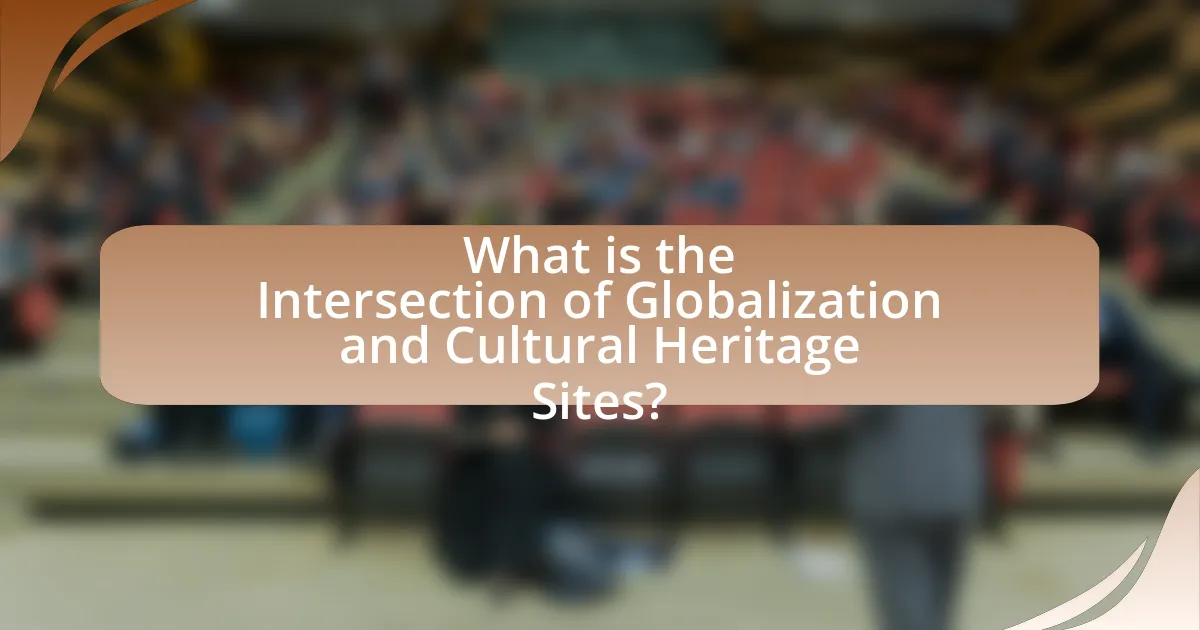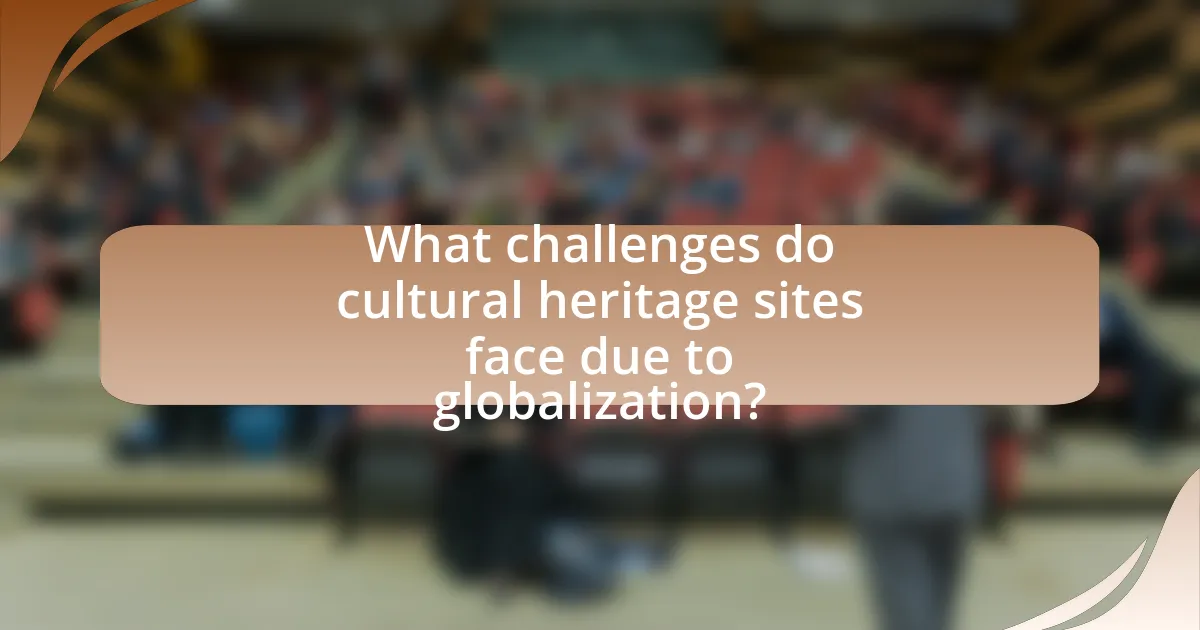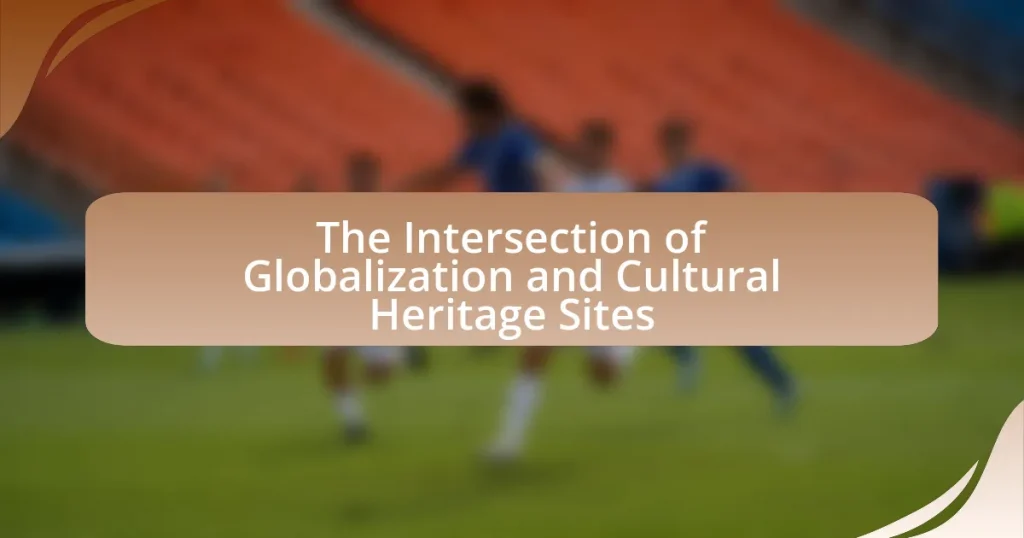The intersection of globalization and cultural heritage sites examines how global interconnectedness impacts the preservation, interpretation, and commercialization of cultural heritage. While globalization enhances tourism and economic opportunities for heritage sites, it also poses risks such as cultural homogenization and the loss of local identities. Key aspects influencing this dynamic include cultural homogenization, economic commercialization, and technological advancements. The article explores the challenges faced by cultural heritage sites due to globalization, including environmental degradation and loss of authenticity, while highlighting strategies for sustainable tourism and community engagement to protect these vital cultural assets.

What is the Intersection of Globalization and Cultural Heritage Sites?
The intersection of globalization and cultural heritage sites refers to the complex relationship where global interconnectedness influences the preservation, interpretation, and commercialization of cultural heritage. Globalization facilitates the exchange of ideas and cultural practices, leading to increased tourism and economic opportunities for heritage sites, but it also poses risks such as cultural homogenization and the potential loss of local identities. For instance, UNESCO’s World Heritage List, which includes over 1,100 sites, highlights the importance of protecting cultural heritage while acknowledging the pressures from global tourism and development. This duality illustrates how globalization can both support and threaten the integrity of cultural heritage sites.
How does globalization influence cultural heritage sites?
Globalization influences cultural heritage sites by increasing tourism and promoting cultural exchange, which can lead to both preservation and commercialization. The influx of international visitors often provides funding and awareness for the conservation of these sites, as seen with UNESCO World Heritage Sites, which receive support for maintenance and protection. However, this same globalization can also result in the commodification of cultural heritage, where local traditions and practices are altered to cater to tourist expectations, potentially diluting their authenticity. For instance, the commercialization of traditional festivals in places like Bali has transformed them into tourist attractions, impacting their original cultural significance.
What are the key aspects of globalization affecting cultural heritage?
The key aspects of globalization affecting cultural heritage include cultural homogenization, economic commercialization, and technological influence. Cultural homogenization occurs as global media and communication promote dominant cultures, often overshadowing local traditions and practices. Economic commercialization manifests through tourism and market demands, which can lead to the commodification of cultural sites, altering their original significance. Technological influence, particularly through digital media, enables wider access to cultural heritage but can also result in the dilution of authentic experiences. These aspects illustrate how globalization reshapes cultural heritage, often prioritizing global narratives over local identities.
How do cultural heritage sites adapt to globalization?
Cultural heritage sites adapt to globalization by integrating modern tourism practices while preserving their historical significance. These sites often enhance visitor experiences through the use of technology, such as virtual tours and interactive exhibits, which attract a global audience. For instance, UNESCO World Heritage Sites have implemented management plans that balance conservation efforts with the economic benefits of tourism, ensuring that local communities also gain from increased visitor numbers. Additionally, many cultural heritage sites engage in partnerships with international organizations to promote sustainable tourism practices, which help maintain their cultural integrity amidst global influences.
Why are cultural heritage sites important in a globalized world?
Cultural heritage sites are important in a globalized world because they serve as vital links to history, identity, and cultural diversity. These sites foster a sense of belonging and continuity for communities, while also promoting intercultural dialogue and understanding among diverse populations. For instance, UNESCO recognizes over 1,100 World Heritage Sites, which attract millions of tourists annually, contributing significantly to local economies and global cultural exchange. This economic impact underscores the role of cultural heritage in sustaining communities amidst globalization, as it encourages the preservation of unique cultural identities in an increasingly homogenized world.
What role do cultural heritage sites play in identity and community?
Cultural heritage sites play a crucial role in shaping identity and fostering community cohesion. These sites serve as tangible representations of a community’s history, values, and traditions, allowing individuals to connect with their cultural roots. For instance, UNESCO recognizes over 1,100 World Heritage Sites, which not only preserve historical narratives but also promote a sense of belonging among community members. Research indicates that engagement with cultural heritage sites enhances social ties and collective identity, as seen in studies conducted by the International Council on Monuments and Sites, which highlight the importance of these sites in community development and cultural continuity.
How do cultural heritage sites contribute to global tourism?
Cultural heritage sites significantly contribute to global tourism by attracting millions of visitors each year, which boosts local economies and promotes cultural exchange. For instance, UNESCO World Heritage Sites, such as the Great Wall of China and the Pyramids of Giza, draw tourists due to their historical significance and unique cultural narratives. According to the United Nations World Tourism Organization, cultural tourism accounts for approximately 40% of global tourism, highlighting the importance of these sites in shaping travel trends and experiences. This influx of tourists not only generates revenue through entrance fees and local spending but also fosters awareness and appreciation of diverse cultures, thereby enhancing global interconnectedness.

What challenges do cultural heritage sites face due to globalization?
Cultural heritage sites face significant challenges due to globalization, primarily including commercialization, loss of authenticity, and environmental degradation. Commercialization occurs as global tourism increases, leading to the commodification of cultural practices and artifacts, which can dilute their historical significance. For instance, UNESCO reports that over 1.5 billion international tourist arrivals were recorded in 2019, placing immense pressure on local cultures and heritage sites.
Loss of authenticity is another critical challenge, as globalization often promotes a homogenized culture that can overshadow local traditions and practices. This phenomenon is evident in cities where traditional architecture is replaced by modern developments catering to global tastes, undermining the unique cultural identity of the area.
Environmental degradation also poses a threat, as increased tourism can lead to pollution and wear on fragile sites. The World Heritage Committee has noted that many sites are at risk due to climate change and unsustainable tourism practices, which can irreversibly damage their integrity. These challenges highlight the complex interplay between globalization and the preservation of cultural heritage.
How does commercialization impact cultural heritage sites?
Commercialization significantly impacts cultural heritage sites by altering their authenticity and accessibility. Increased commercialization often leads to the commodification of cultural heritage, where sites are transformed into tourist attractions that prioritize profit over preservation. For instance, UNESCO reports that sites like Venice and Machu Picchu face challenges due to mass tourism driven by commercial interests, which can result in environmental degradation and loss of cultural significance. Furthermore, commercialization can lead to the dilution of local traditions as communities adapt their practices to meet tourist expectations, thereby undermining the original cultural context.
What are the effects of mass tourism on cultural heritage preservation?
Mass tourism negatively impacts cultural heritage preservation by accelerating wear and tear on historical sites and diluting local traditions. Increased foot traffic can lead to physical damage, as seen in places like the ancient city of Pompeii, where millions of visitors contribute to the deterioration of structures. Additionally, mass tourism often prioritizes commercial interests over authentic cultural experiences, resulting in the commodification of heritage. For instance, UNESCO has reported that sites like Venice face challenges in maintaining their cultural integrity due to overwhelming tourist numbers, which can lead to a loss of local identity and traditions.
How can cultural authenticity be maintained amidst globalization?
Cultural authenticity can be maintained amidst globalization by actively promoting and preserving local traditions, languages, and practices. This involves implementing policies that support cultural education, community engagement, and the protection of cultural heritage sites. For instance, UNESCO’s World Heritage program emphasizes the importance of safeguarding cultural sites and practices, which helps to ensure that local identities are not overshadowed by global influences. Additionally, initiatives that encourage local artisans and cultural practitioners to thrive economically can reinforce the value of authentic cultural expressions, thereby fostering resilience against homogenizing global trends.
What are the environmental impacts of globalization on cultural heritage sites?
Globalization negatively impacts cultural heritage sites by increasing environmental degradation and resource depletion. The influx of tourism, driven by globalization, leads to soil erosion, pollution, and habitat destruction around these sites. For instance, UNESCO reports that sites like Machu Picchu in Peru face significant threats from increased visitor numbers, which contribute to the deterioration of the landscape and infrastructure. Additionally, globalization often promotes industrial development and urbanization near heritage sites, further exacerbating environmental stress and compromising their integrity.
How does urban development threaten cultural heritage sites?
Urban development threatens cultural heritage sites primarily through physical destruction, alteration of historical landscapes, and increased commercialization. As cities expand, construction projects often encroach upon or demolish sites of historical significance, leading to irreversible loss of cultural identity. For instance, UNESCO has reported that urbanization has led to the degradation of numerous World Heritage Sites, such as the ancient city of Aleppo in Syria, where ongoing development and conflict have resulted in significant damage to its historical architecture. Additionally, urban development can lead to the commodification of cultural heritage, transforming sites into tourist attractions that prioritize profit over preservation, thereby diluting their historical and cultural value.
What measures can be taken to mitigate environmental risks?
To mitigate environmental risks, implementing sustainable practices is essential. These practices include reducing carbon emissions through renewable energy sources, enhancing waste management systems, and promoting biodiversity conservation. For instance, transitioning to renewable energy can decrease greenhouse gas emissions significantly; according to the International Renewable Energy Agency, renewable energy could reduce global CO2 emissions by up to 70% by 2050. Additionally, effective waste management, such as recycling and composting, can minimize landfill use and pollution. Furthermore, protecting biodiversity through conservation efforts helps maintain ecosystem balance, which is crucial for environmental resilience.

What strategies can be employed to protect cultural heritage sites in a globalized context?
To protect cultural heritage sites in a globalized context, strategies such as implementing strict legal frameworks, promoting community engagement, and utilizing technology for monitoring and preservation are essential. Legal frameworks, like the UNESCO World Heritage Convention, provide guidelines for safeguarding sites against exploitation and degradation. Community engagement fosters local stewardship, ensuring that residents actively participate in the protection and promotion of their cultural heritage. Additionally, technology, including satellite imagery and digital documentation, enhances monitoring efforts and facilitates restoration processes, as evidenced by the successful use of 3D scanning in preserving sites like the ancient city of Palmyra in Syria. These strategies collectively contribute to the effective protection of cultural heritage in an increasingly interconnected world.
How can local communities engage in the preservation of cultural heritage?
Local communities can engage in the preservation of cultural heritage by actively participating in heritage management initiatives and promoting local traditions. This involvement can include organizing cultural festivals, workshops, and educational programs that highlight the significance of local customs and historical sites. For instance, communities can collaborate with local governments and heritage organizations to create conservation plans that protect historical landmarks, as seen in successful projects like the UNESCO World Heritage Sites, where local input is crucial for sustainable preservation. Additionally, community-led initiatives, such as volunteer clean-up days at heritage sites, foster a sense of ownership and responsibility towards cultural heritage, ensuring its transmission to future generations.
What role do governments play in protecting cultural heritage sites?
Governments play a crucial role in protecting cultural heritage sites by establishing legal frameworks, funding preservation efforts, and promoting awareness. They create laws and regulations, such as the UNESCO World Heritage Convention, which provides guidelines for the protection of sites deemed of outstanding universal value. Additionally, governments allocate financial resources for restoration projects and maintenance, ensuring that these sites are preserved for future generations. For instance, the Italian government invests millions annually in the preservation of its historical sites, reflecting its commitment to cultural heritage. Furthermore, governments engage in international cooperation to safeguard cultural heritage, exemplified by initiatives like the 1970 UNESCO Convention, which aims to prevent the illicit trade of cultural property.
How can international cooperation enhance cultural heritage protection?
International cooperation enhances cultural heritage protection by facilitating resource sharing, knowledge exchange, and coordinated efforts to combat threats such as looting and climate change. Collaborative initiatives, such as UNESCO’s World Heritage program, enable countries to work together to safeguard sites of global significance, ensuring that best practices in conservation are implemented. For instance, the 1970 UNESCO Convention on the Means of Prohibiting and Preventing the Illicit Import, Export and Transfer of Ownership of Cultural Property has led to increased international legal frameworks that protect cultural heritage from illegal trade. This cooperation not only strengthens legal protections but also fosters a global awareness of the importance of preserving cultural heritage for future generations.
What best practices can be adopted for sustainable tourism at cultural heritage sites?
Best practices for sustainable tourism at cultural heritage sites include implementing visitor management strategies, promoting local culture, and ensuring environmental conservation. Visitor management strategies, such as limiting the number of tourists and establishing timed entry, help reduce overcrowding and preserve the integrity of the site. Promoting local culture through community engagement and supporting local artisans fosters economic benefits while enhancing the visitor experience. Environmental conservation practices, such as waste management and sustainable transportation options, protect the natural surroundings and cultural assets. These practices are supported by studies indicating that sustainable tourism can enhance both the visitor experience and the preservation of cultural heritage, as seen in successful models like the UNESCO World Heritage Sites program.
How can visitor education contribute to heritage conservation?
Visitor education significantly contributes to heritage conservation by fostering awareness and appreciation of cultural sites among tourists. Educated visitors are more likely to respect the integrity of heritage sites, leading to reduced vandalism and degradation. For instance, studies have shown that informed tourists tend to follow guidelines and regulations, which helps preserve the physical and cultural aspects of these sites. Additionally, educational programs can enhance visitors’ understanding of the historical significance of heritage, encouraging them to support conservation efforts financially or through advocacy. This relationship between education and conservation is supported by research indicating that heritage sites with robust visitor education programs experience better preservation outcomes.
What are effective models for community-based tourism?
Effective models for community-based tourism include cooperative management, cultural immersion experiences, and sustainable development initiatives. Cooperative management involves local communities collaborating with tourism operators to share profits and decision-making, ensuring that the benefits of tourism directly support the community. Cultural immersion experiences allow tourists to engage with local traditions, crafts, and lifestyles, fostering a deeper understanding and appreciation of the culture. Sustainable development initiatives focus on preserving natural and cultural resources while promoting economic growth, often supported by frameworks like the United Nations’ Sustainable Development Goals. These models have been validated by successful case studies, such as the community-based tourism projects in Costa Rica, which have shown increased local income and enhanced cultural preservation.
What are the future trends in the intersection of globalization and cultural heritage sites?
Future trends in the intersection of globalization and cultural heritage sites include increased digital preservation, enhanced global collaboration for conservation, and a growing emphasis on sustainable tourism practices. Digital preservation technologies, such as 3D scanning and virtual reality, allow for the documentation and sharing of cultural heritage sites globally, making them accessible to a wider audience while preserving their integrity. Collaborative efforts among nations and organizations, exemplified by initiatives like UNESCO’s World Heritage program, aim to protect and manage these sites collectively, fostering international partnerships. Additionally, sustainable tourism practices are gaining traction, as stakeholders recognize the need to balance visitor access with the preservation of cultural heritage, ensuring that local communities benefit economically while maintaining their cultural identity. These trends reflect a response to the challenges posed by globalization, aiming to protect cultural heritage in an interconnected world.
How might technology influence the preservation of cultural heritage?
Technology significantly influences the preservation of cultural heritage by enabling advanced documentation, restoration, and accessibility methods. Digital tools such as 3D scanning and modeling allow for precise documentation of artifacts and sites, ensuring that even if physical deterioration occurs, a detailed digital record remains. For instance, the use of 3D printing has facilitated the restoration of damaged artifacts, allowing for accurate replicas to be created, as seen in the restoration of the Parthenon sculptures. Additionally, virtual reality and augmented reality applications provide immersive experiences that educate the public about cultural heritage, enhancing awareness and appreciation. According to a report by UNESCO, technology-driven initiatives have increased global engagement with cultural heritage sites, demonstrating that technology not only aids in preservation but also fosters a deeper connection between communities and their cultural identities.
What emerging global policies could impact cultural heritage sites?
Emerging global policies that could impact cultural heritage sites include international agreements on climate change, such as the Paris Agreement, which aims to mitigate environmental threats to heritage sites through sustainable practices. Additionally, UNESCO’s Global Strategy for a Representative, Balanced and Credible World Heritage List promotes the protection of cultural heritage by encouraging countries to prioritize preservation in their national policies. These policies are crucial as they address the increasing risks posed by urbanization, tourism, and climate change, which threaten the integrity and preservation of cultural heritage sites worldwide.
What practical steps can be taken to balance globalization and cultural heritage preservation?
To balance globalization and cultural heritage preservation, governments and organizations can implement policies that promote sustainable tourism and support local cultures. Sustainable tourism initiatives, such as those outlined by the United Nations World Tourism Organization, emphasize responsible travel practices that respect cultural sites and communities. Additionally, local governments can establish regulations that limit commercial development in heritage areas, ensuring that economic growth does not compromise cultural integrity. Educational programs that raise awareness about the importance of cultural heritage can also foster community engagement and pride, encouraging locals to participate in preservation efforts. These steps are supported by research indicating that communities actively involved in heritage conservation are more resilient to the pressures of globalization.










